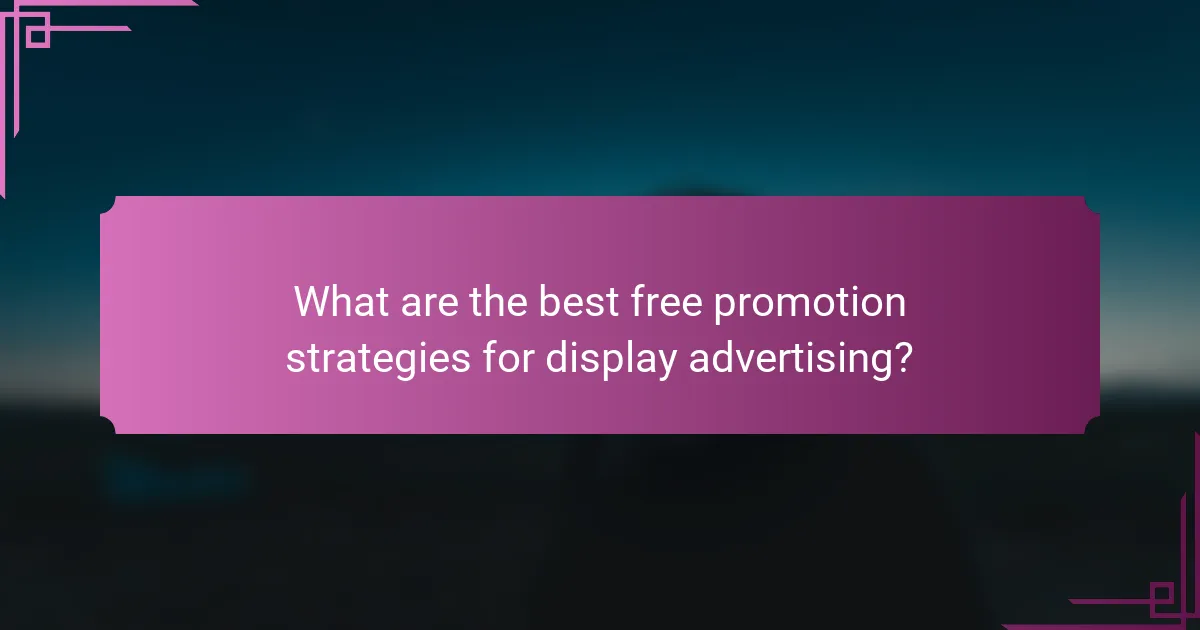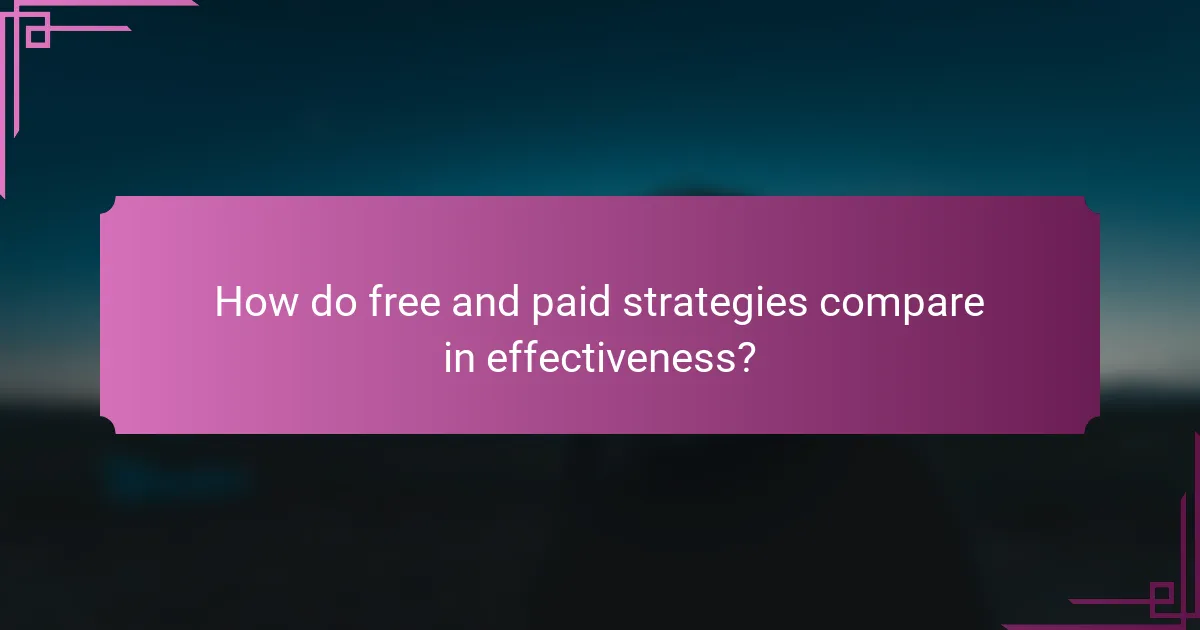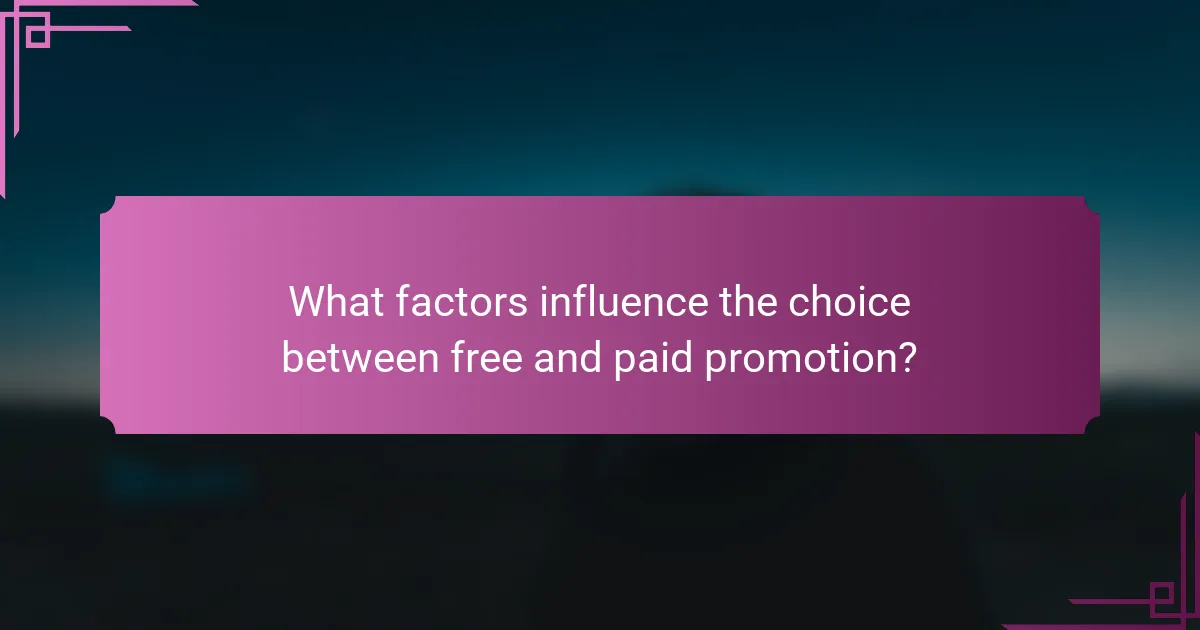Choosing between free and paid promotion strategies depends on your marketing goals and available resources. Free methods, such as social media and content creation, can enhance visibility over time without financial investment, making them suitable for budget-conscious marketers. In contrast, paid strategies offer immediate reach and are ideal for time-sensitive campaigns or competitive markets, allowing for targeted audience engagement.

What are the best free promotion strategies for display advertising?
The best free promotion strategies for display advertising include leveraging social media, creating valuable content, utilizing email marketing, and optimizing for search engines. Each method can effectively increase visibility and engagement without incurring costs, making them ideal for budget-conscious marketers.
Social media marketing
Social media marketing involves using platforms like Facebook, Instagram, and Twitter to promote your display ads. By sharing engaging content and interacting with followers, you can organically boost your brand’s visibility and drive traffic to your website.
To maximize effectiveness, focus on platforms where your target audience is most active. Regularly post updates, use relevant hashtags, and engage with comments to foster community and encourage sharing.
Content marketing
Content marketing entails creating valuable and informative content that attracts and retains an audience. This can include blog posts, infographics, or videos that relate to your display advertising goals.
By providing useful information, you can establish authority in your niche and encourage visitors to share your content, indirectly promoting your display ads. Aim for high-quality, shareable content that resonates with your audience’s interests.
Email marketing
Email marketing allows you to reach your audience directly by sending newsletters or promotional emails. Building a subscriber list is crucial; offer incentives like exclusive content or discounts to encourage sign-ups.
Craft compelling subject lines and personalized messages to improve open rates. Regularly share updates about your display ads and related content to keep your audience engaged and informed.
Search engine optimization
Search engine optimization (SEO) focuses on improving your website’s visibility in search engine results. By optimizing your content with relevant keywords, you can attract organic traffic to your display ads.
Consider on-page SEO techniques, such as optimizing title tags, meta descriptions, and image alt texts. Additionally, building backlinks from reputable sites can enhance your site’s authority and improve search rankings.

When should you use paid promotion strategies?
Paid promotion strategies are best utilized when immediate visibility and reach are critical for your marketing goals. These strategies can effectively boost your presence in competitive markets, support time-sensitive campaigns, and help you reach specific audience segments.
High competition markets
In high competition markets, organic reach may not suffice to stand out. Paid promotions can provide a significant advantage by placing your content directly in front of potential customers who are already searching for similar products or services. Consider allocating a budget for pay-per-click (PPC) ads or social media promotions to enhance your visibility against competitors.
For instance, if you operate in a saturated e-commerce space, investing in targeted ads on platforms like Google Ads or Facebook can help you capture attention quickly, especially if your competitors are already using these channels.
Time-sensitive campaigns
When running time-sensitive campaigns, such as product launches or seasonal promotions, paid strategies can deliver rapid results. These promotions allow you to reach your audience quickly, ensuring that your message is seen before the opportunity passes. Utilize countdown timers or limited-time offers in your ads to create urgency.
For example, if you are promoting a holiday sale, using paid ads to reach customers in the weeks leading up to the event can maximize your sales potential and ensure your offer is top-of-mind.
Targeted audience reach
Paid promotion strategies excel at reaching specific audience segments that may be difficult to engage through organic methods. Platforms like Facebook and LinkedIn allow for precise targeting based on demographics, interests, and behaviors. This capability ensures that your message is delivered to the right people, increasing the likelihood of conversion.
For instance, if you are launching a new tech gadget aimed at young professionals, you can target ads specifically to users who fit that demographic, enhancing your chances of engagement and sales.

How do free and paid strategies compare in effectiveness?
Free and paid promotion strategies differ significantly in effectiveness based on objectives and resources. Free strategies often build organic reach over time, while paid strategies deliver immediate visibility and engagement.
Cost-effectiveness of free strategies
Free promotion strategies are generally more cost-effective, as they require minimal financial investment. Techniques such as social media marketing, content creation, and search engine optimization (SEO) can yield substantial results without direct costs.
However, they often demand a significant time investment and consistent effort to achieve desired outcomes. For instance, building a following on social media organically can take months or even years, depending on the niche.
Immediate results from paid strategies
Paid promotion strategies provide immediate results, making them ideal for time-sensitive campaigns. Advertisements on platforms like Google Ads or Facebook Ads can generate traffic and leads within hours of launching.
This approach allows businesses to target specific demographics and locations, ensuring that the right audience sees their message quickly. However, it’s crucial to monitor performance metrics closely to maximize return on investment.
Long-term benefits of free strategies
Free strategies can offer long-term benefits by fostering brand loyalty and organic engagement. As content gains traction, it can continue to attract viewers and potential customers over time, creating a sustainable presence.
Additionally, free strategies often enhance credibility and trust, as audiences tend to value organic content more than paid advertisements. Investing in quality content and community engagement can lead to a loyal customer base that supports the brand for years.

What factors influence the choice between free and paid promotion?
The choice between free and paid promotion strategies depends on several factors including budget, target audience, and specific campaign goals. Understanding these elements helps marketers decide which approach will yield the best results for their objectives.
Budget constraints
Budget is a primary factor when deciding between free and paid promotion. Free methods, such as social media posts and organic search optimization, require minimal financial investment but can demand significant time and effort. In contrast, paid promotions, like pay-per-click advertising or sponsored social media posts, can quickly consume a budget, often requiring hundreds to thousands of dollars depending on the scope.
When assessing budget constraints, consider setting a clear limit for paid promotions. For example, small businesses might allocate 10-20% of their revenue to marketing, while larger firms may invest more heavily. Always evaluate the potential return on investment to ensure the budget aligns with expected outcomes.
Target audience demographics
Understanding your target audience’s demographics is crucial in choosing the right promotion strategy. Free promotions may work well for reaching younger audiences who are more active on social media platforms, while paid promotions can be effective in targeting specific demographics through advanced ad targeting options.
Consider factors like age, location, and interests when selecting your promotional strategy. For instance, if your audience consists of professionals aged 30-50, platforms like LinkedIn may be more effective for paid promotions, while Instagram may be better for a younger demographic.
Campaign objectives
Your campaign objectives significantly influence the choice between free and paid promotion. If the goal is to build brand awareness over time, free strategies like content marketing and social media engagement may suffice. However, if immediate sales or leads are the target, paid promotions can provide quicker results.
Clearly define your objectives before launching a campaign. For example, if you aim to increase website traffic by 50% in a month, a paid search campaign might be necessary. Conversely, for long-term engagement, a consistent free content strategy may be more appropriate. Always align your promotional approach with your specific goals to maximize effectiveness.

How can you measure the success of promotion strategies?
Measuring the success of promotion strategies involves analyzing various metrics that reflect their effectiveness. By utilizing analytics tools and key performance indicators (KPIs), businesses can evaluate the impact of both free and paid promotions on their goals.
Analytics tools for tracking
Analytics tools are essential for monitoring the performance of promotion strategies. Platforms like Google Analytics, Facebook Insights, and HubSpot provide valuable data on user engagement, traffic sources, and conversion rates. These tools help businesses understand which promotional efforts yield the best results.
When selecting an analytics tool, consider factors such as ease of use, integration capabilities, and the specific metrics you want to track. For example, if your focus is on social media promotions, tools that specialize in social analytics may offer deeper insights.
Key performance indicators
Key performance indicators (KPIs) are critical for assessing the success of your promotion strategies. Common KPIs include conversion rates, click-through rates, and customer acquisition costs. These metrics provide a clear picture of how well your promotions are performing against your objectives.
Establishing specific KPIs before launching a promotion can guide your strategy. For instance, if your goal is to increase website traffic, track the number of visitors generated from your promotional efforts. Regularly reviewing these KPIs allows for timely adjustments to optimize performance.
Return on investment analysis
Return on investment (ROI) analysis is a vital component of measuring promotion success. It involves comparing the revenue generated from a promotion against the costs incurred. A positive ROI indicates that your promotional strategy is effective, while a negative ROI suggests a need for reevaluation.
To calculate ROI, use the formula: (Net Profit / Cost of Promotion) x 100. For example, if a paid ad campaign costs $500 and generates $1,500 in sales, the ROI would be 200%. Regularly conducting ROI analyses helps businesses make informed decisions about future promotional investments.

